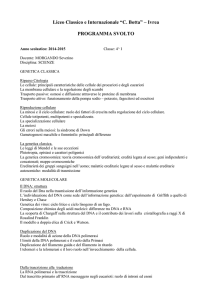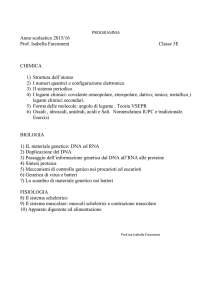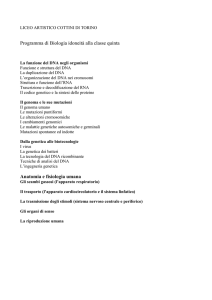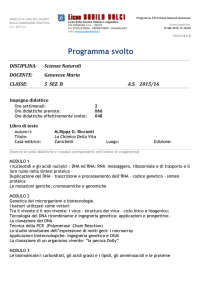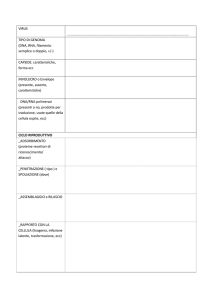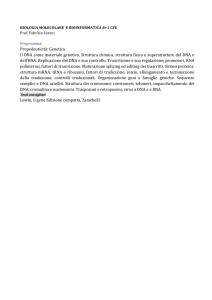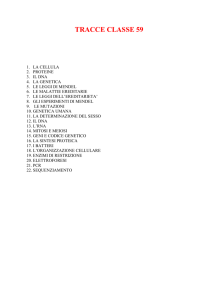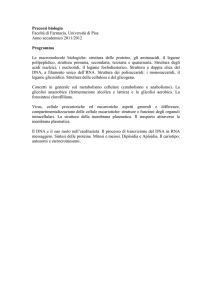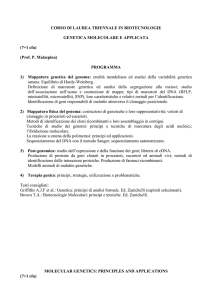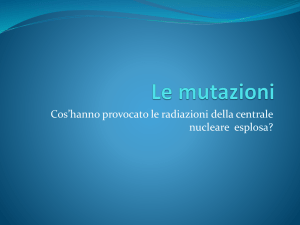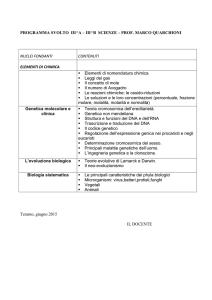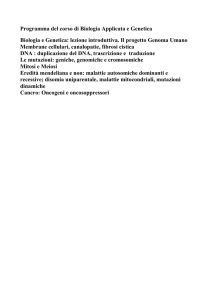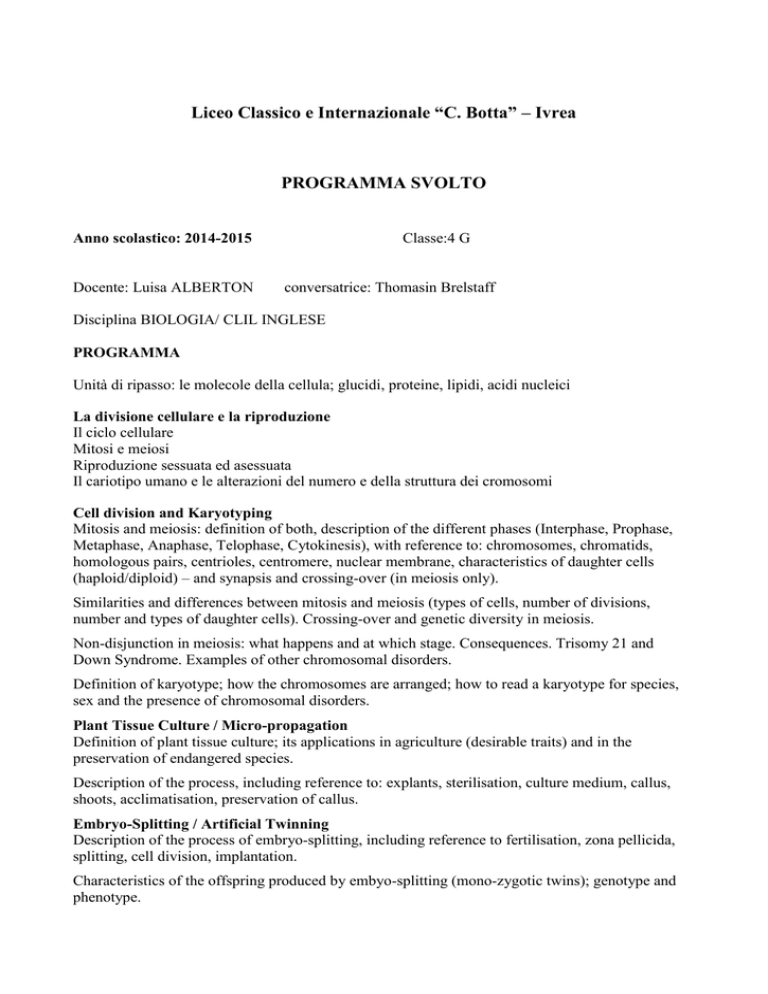
Liceo Classico e Internazionale “C. Botta” – Ivrea
PROGRAMMA SVOLTO
Anno scolastico: 2014-2015
Docente: Luisa ALBERTON
Classe:4 G
conversatrice: Thomasin Brelstaff
Disciplina BIOLOGIA/ CLIL INGLESE
PROGRAMMA
Unità di ripasso: le molecole della cellula; glucidi, proteine, lipidi, acidi nucleici
La divisione cellulare e la riproduzione
Il ciclo cellulare
Mitosi e meiosi
Riproduzione sessuata ed asessuata
Il cariotipo umano e le alterazioni del numero e della struttura dei cromosomi
Cell division and Karyotyping
Mitosis and meiosis: definition of both, description of the different phases (Interphase, Prophase,
Metaphase, Anaphase, Telophase, Cytokinesis), with reference to: chromosomes, chromatids,
homologous pairs, centrioles, centromere, nuclear membrane, characteristics of daughter cells
(haploid/diploid) – and synapsis and crossing-over (in meiosis only).
Similarities and differences between mitosis and meiosis (types of cells, number of divisions,
number and types of daughter cells). Crossing-over and genetic diversity in meiosis.
Non-disjunction in meiosis: what happens and at which stage. Consequences. Trisomy 21 and
Down Syndrome. Examples of other chromosomal disorders.
Definition of karyotype; how the chromosomes are arranged; how to read a karyotype for species,
sex and the presence of chromosomal disorders.
Plant Tissue Culture / Micro-propagation
Definition of plant tissue culture; its applications in agriculture (desirable traits) and in the
preservation of endangered species.
Description of the process, including reference to: explants, sterilisation, culture medium, callus,
shoots, acclimatisation, preservation of callus.
Embryo-Splitting / Artificial Twinning
Description of the process of embryo-splitting, including reference to fertilisation, zona pellicida,
splitting, cell division, implantation.
Characteristics of the offspring produced by embyo-splitting (mono-zygotic twins); genotype and
phenotype.
Advantages and disadvantages/limitations of producing livestock by embryo-splitting.
Somatic Cell Nuclear Transfer
Description of the process of SCNT, including reference to: unfertilised, de-nucleated egg cell,
nucleus of a dormant somatic cell, fusion, activation, implantation.
Characteristics of offspring produced by SCNT: genotype and phenotype.
Advantages and disadvantages/limitations of SCNT.
Significance/Implications of the successful cloning of Dolly the sheep.
Modelli di ereditarietà
Le leggi di Mendel
Estensione della genetica mendeliana: codominanza, dominanza incompleta, alleli multipli,
pleiotropia, eredità poligenica
L’eredità legata al sesso
Geni indipendenti e associati. Il ruolo del crossing over: frequenza di ricombinazione e mappatura
genetica
Genetica umana
Le malattie genetiche
Genetic Disorders
Definition of the terms: gene, allele, dominant, recessive, genetic disorder.
Brief description of some genetic disorders (symptoms, causes, possible treatment, inheritance),
including: Polydactyly, Huntingdon’s, Sickle Cell Anaemia, Phenylketonuria (PKU), Tay Sachs,
Cystic Fibrosis, Haemophilia.
Calculation of probability of inheriting a particular genetic disorder from given data about parents.
Biologia molecolare del gene
Dalle leggi di Mendel alla struttura del materiale genetico
Struttura e duplicazione del DNA
Il passaggio dell’informazione genetica dal DNA all’RNA alle proteine: la sintesi proteica ed il
codice genetico
La genetica dei virus e dei batteri: trasformazione, trasduzione, coniugazione. Il ruolo dei plasmidi
DNA and RNA
Definition of DNA and RNA: their functions and where they are found.
The structure of a nucleotide, including the differences in sugars and bases in DNA and RNA.
How nucleotides join together to form strands of DNA or RNA. Pairing rules for bases and types of
bonds formed. Structural difference between DNA and RNA.
The double helix structure of DNA and the anti-parallel arrangement of the strands (5 prime and 3
prime).
Ivrea, giugno 2015
Il Docente

